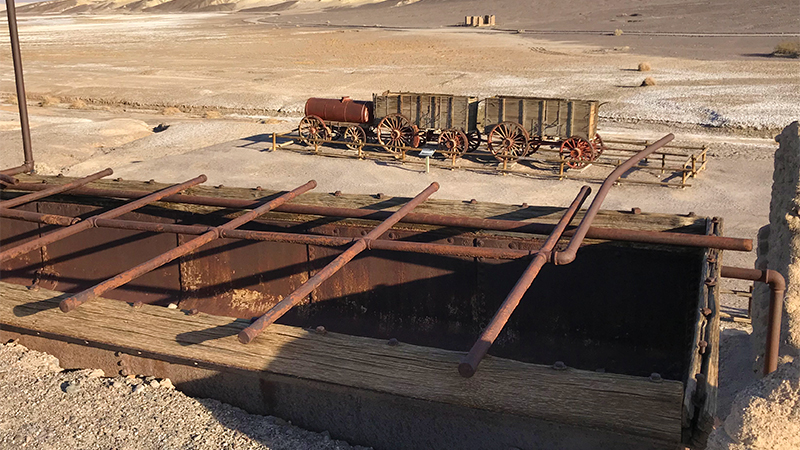
After walking the Salt Creek Interpretive Trail as the sun rose, we had just enough time to check out the Harmony Borax Works Interpretive Trail before heading back to the hotel for a quick morning business video chat and a visit to the Borax Museum before heading into the mountains to visit Mustard Canyon, Keane Wonder Mine, Zabriskie Point, 20 Mule Team Canyon, and Dante’s View.
There was only one other person visiting the remains of this borax processing plant when we arrived, so we had almost the entire place to ourselves to explore.
The short easy trail took us past an old furnace and crumbling borax processing building, an original Twenty Mule Team carriage, and some old rusty equipment. After completing the trail, we walked over to explore the remnants of a couple adobe buildings from the company village.
Borax, called the White Gold Of The Desert, ranks as the valley’s most profitable mineral and was used by blacksmiths, potters, dairy farmers, housewives, meat packers, and even morticians.
A trip to the Harmony Borax Works is a roughly 20-minute excursion that provides a short yet fascinating glimpse into the industry of Death Valley.
Harmony Borax Works History
Harmony Borax Works was the central feature in the opening of Death Valley and the popularity of the Furnace Creek area. The plant and associated townsite played an important role in Death Valley history.
After the discovery of Borax near Furnace Creek Ranch (then called Greenland) by Aaron and Rosie Winters in 1881, business associates William Tell Coleman and Francis Marion Smith obtained claims to these deposits, opening the way for borax mining in Death Valley.
The Harmony plant was built in late 1883 or early 1884. When in full operation, the Harmony Borax Works employed 40 men who produced three tons of borax daily, and in the sweltering summers, the crew was moved to the Amargosa Borax Plant near present day Tecopa, California.
Getting the finished product to market from the heart of Death Valley was a difficult. The Harmony Borax operation became famous through the use of Twenty Mule Teams — large mule teams and double wagons that hauled borax to Mojave. One Twenty Mule Team loaded and left the plant every four days, traveling 165 miles across the desert to the railroad and back in about twenty days.
Harmony Borax Works closed in 1888, after only five years, when the owner’s financial empire collapsed. In time, it became part of the borax reserves of the Pacific Coast Borax Company, who began marketing it under the iconic 20 Mule Team trademark. On December 31, 1974, Harmony Borax Works was placed on the National Register of Historic Places.
Know Before You Go
- The Harmony Borax Works Interpretive Trail is located off CA-190 on a paved two mile road in Furnace Creek, California 92328 within Death Valley National Park in Inyo County.
- The Interpretive Trail is an ADA-accessible, half-mile loop with informational displays that explain details of the borax processing, the story of the Mule Skinner, life in Harmony, and its impact on Death Valley. On the trail, you’ll pass an old furnace and borax processing building, an original 20 Mule Team carriage, and the remains of a couple adobe buildings.
- There are no restrooms at the Harmony Borax Works site. The closest restrooms are at the Furnace Creek Visitor Center, one mile east on CA-190.
- The entrance to Mustard Canyon Drive can be found at the end of the Harmony Borax Works parking area.
- Dogs are allowed, but must be kept on a leash.






